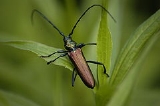
Musk beetle
Encyclopedia
The musk beetle is a Eurasia
n species of longhorn beetle
belonging to the subfamily Cerambycinae
, tribe Callichromatini. Its name comes from the musky smell it emits.
, except for most of Spain and the Southern Italy
. In such regions, in North Africa
, and in Asia
to Japan
, the species is represented by some subspecies characterised by a more or less red pronotum. The antennae are longer than the entire head and body length in male and as long as body in females. Nevertheless, the Oriental subspecies have usually shorter antennae.
It can be found in Great Britain
locally, for example Butomus umbellatus at Caldicot and Wentloog Levels
otherwise known as Gwent Levels SSSI
trees, where the larva of this species lives.

Eurasia
Eurasia is a continent or supercontinent comprising the traditional continents of Europe and Asia ; covering about 52,990,000 km2 or about 10.6% of the Earth's surface located primarily in the eastern and northern hemispheres...
n species of longhorn beetle
Longhorn beetle
The longhorn beetles are a cosmopolitan family of beetles, typically characterized by extremely long antennae, which are often as long as or longer than the beetle's body...
belonging to the subfamily Cerambycinae
Cerambycinae
Cerambycinae is a subfamily of the longhorn beetle family . The subfamily includes over 750 genera, rivaled in diversity within the family only by the subfamily...
, tribe Callichromatini. Its name comes from the musky smell it emits.
Description
This beetle is characterised by a somewhat coppery or greenish metallic tint. The typical form, characterised by a metallic pronotum, is widespread in EuropeEurope
Europe is, by convention, one of the world's seven continents. Comprising the westernmost peninsula of Eurasia, Europe is generally 'divided' from Asia to its east by the watershed divides of the Ural and Caucasus Mountains, the Ural River, the Caspian and Black Seas, and the waterways connecting...
, except for most of Spain and the Southern Italy
Italy
Italy , officially the Italian Republic languages]] under the European Charter for Regional or Minority Languages. In each of these, Italy's official name is as follows:;;;;;;;;), is a unitary parliamentary republic in South-Central Europe. To the north it borders France, Switzerland, Austria and...
. In such regions, in North Africa
North Africa
North Africa or Northern Africa is the northernmost region of the African continent, linked by the Sahara to Sub-Saharan Africa. Geopolitically, the United Nations definition of Northern Africa includes eight countries or territories; Algeria, Egypt, Libya, Morocco, South Sudan, Sudan, Tunisia, and...
, and in Asia
Asia
Asia is the world's largest and most populous continent, located primarily in the eastern and northern hemispheres. It covers 8.7% of the Earth's total surface area and with approximately 3.879 billion people, it hosts 60% of the world's current human population...
to Japan
Japan
Japan is an island nation in East Asia. Located in the Pacific Ocean, it lies to the east of the Sea of Japan, China, North Korea, South Korea and Russia, stretching from the Sea of Okhotsk in the north to the East China Sea and Taiwan in the south...
, the species is represented by some subspecies characterised by a more or less red pronotum. The antennae are longer than the entire head and body length in male and as long as body in females. Nevertheless, the Oriental subspecies have usually shorter antennae.
It can be found in Great Britain
Great Britain
Great Britain or Britain is an island situated to the northwest of Continental Europe. It is the ninth largest island in the world, and the largest European island, as well as the largest of the British Isles...
locally, for example Butomus umbellatus at Caldicot and Wentloog Levels
Caldicot and Wentloog Levels
The Caldicot and Wentloog Levels are two areas of low-lying estuarine alluvial wetland and intertidal mudflats adjoining the north bank of the Severn estuary, either side of the River Usk estuary near Newport in south east Wales...
otherwise known as Gwent Levels SSSI
Biology
The adults are usually found on leaves, especially those of the willowWillow
Willows, sallows, and osiers form the genus Salix, around 400 species of deciduous trees and shrubs, found primarily on moist soils in cold and temperate regions of the Northern Hemisphere...
trees, where the larva of this species lives.
Systematic
- subspecies Aromia moschata ambrosiaca Steven & Sherman, 1809
- form Aromia moschata ambrosiaca f. typica
- aberration A. m. a. ab. laevithorax Plavilstshikov
- aberration A. m. a. ab. thoracica Fischer
- aberration A. m. a. ab. melancholica Reitter
- aberration A. m. a. ab. obscurata Plavilstshikov
- aberration A. m. a. ab. notaticollis Pic
- aberration A. m. a. ab. bineava Reitter
- subspecies Aromia moschata cruenta Bogatschev, 1962
- subspecies Aromia moschata jankovskyi Danilevsky, 2007
- subspecies Aromia moschata moschata (Linnaeus, 1758)
- form Aromia moschata moschata f. typica
- aberration A. m. m. ab. auctumnalis Westwood, 1881
- aberration A. m. m. ab. combinata Podaný, 1957
- aberration A. m. m. ab. cupricollis Pic, 1941
- aberration A. m. m. ab. laevicollis Reitter, 1907
- aberration A. m. m. ab. nigra Schil., 1889
- aberration A. m. m. ab. nigrocyanea Reitter, 1906
- aberration A. m. m. ab. nigrolaevigata Plavilstshikov, 1934
- aberration A. m. m. ab. perroudi Pic, 1941
- aberration A. m. m. ab. picipes Reitter, 1906
- aberration A. m. m. ab. pulchra Podaný, 1953
- aberration A. m. m. ab. rumenica Podaný, 1953
- aberration A. m. m. ab. sekerai Podaný, 1957
- aberration A. m. m. ab. semitestacea Heyden, 1941
- aberration A. m. m. ab. steinmanni Tippmann, 1956
- aberration A. m. m. ab. versicolora Donisthorpe
- subspecies Aromia moschata orientalis Plavilstshikov, 1932
- subspecies Aromia moschata sumbarensis Danilevsky, 2007
- subspecies Aromia moschata thoracica Fisher, 1824
- subspecies Aromia moschata vetusta Jankovsky, 1934


